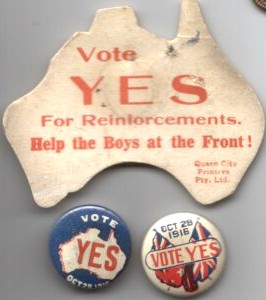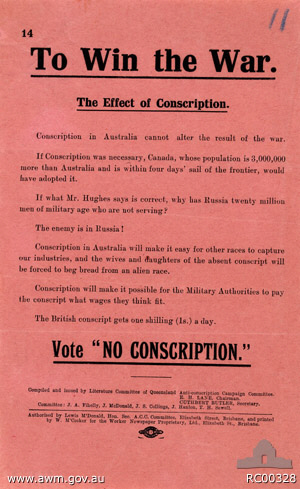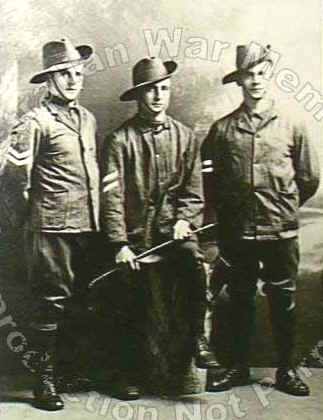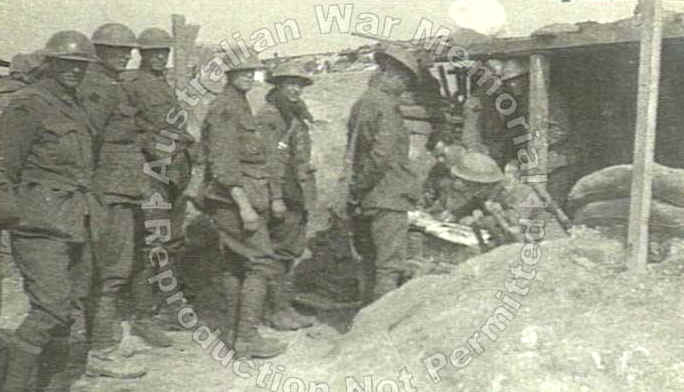| During the
Crimean War 1853-56
the South
Australian colonial government passed the Militia Act 1854 enabling it
to select men by ballot to undergo four weeks military training
annually. In fact, the forces raised were volunteers, and, until the
Defence Act of 1894, it was unclear whether they legally remained
civilians, albeit in uniform.
That Act provided that the members of the
volunteer militias were 'soldiers' who were subject to military
discipline, and liable to serve in any Australian colony. Amendments in
1896 allowed for compulsory military service should a state of emergency
be proclaimed. However, conscription by ballot was only to be used after
a call for volunteers. In the event, the ballot was never used and the
South Australians who fought in
South Africa 1899-1902
were volunteers.
As early as July 1901, the possibility of universal
military training was discussed in the new Federal Parliament. The
Commonwealth's Defence Act of 1903, as amended in 1911, provided for
universal military training. This was strongly opposed by many South
Australians. An account of the work of the Australian Freedom League, an
organization founded by the South Australian Quakers in co-operation
with other interested Christian groups, can be found in Charles
Stevenson's publication, The
millionth snowflake; the history of Quakers in South Australia.
The Library's archival collections contain detailed
information about the unsuccessful attempts of two brothers, Llewellyn
and John Jarman of Kingston in the south-east, to be exempted from the
military service. Records include the brothers' personal
papers, court
applications, legal
advice, newspaper
articles and letters
to the editor.
Although
the Defence Act required men to undergo training with the militia, it
specified that no Australian (including members of the regular military
forces) could be compelled to serve overseas.
Following the outbreak of the First
World War in August 1914, initially volunteers flocked to the
Australian Imperial Force (AIF) for overseas service. By 1916 there were
insufficient new volunteers to cover the AIF's massive casualties and
to meet the British authorities requests for reinforcements. The Prime
Minister, WM Hughes, directly
appealed to all eligible men to volunteer. His plea was supported by
the work of patriotic
organisations, and a campaign of propaganda
posters, to raise more volunteers.
 |
When it appeared that the recruitment targets would
not be met, the government sought approval, by way of a referendum on
October 1916, to require men conscripted into militia training to also
undertake overseas service. The referendum of 28 October 1916 asked
Australians:
Are you in favour of the Government having, in
this grave emergency, the same compulsory powers over citizens in
regard to requiring their military service, for the term of this War,
outside the Commonwealth, as it now has in regard to military service
within the Commonwealth? |
| Colour
leaflet against conscription.
"To Win the War. The Effect of Conscription. Conscription in
Australia cannot alter the result of the war.
If Conscription was necessary,
Canada, whose population is 3,000,000 more than Australia and is
within four days' sail of the frontier, would have adopted
it.
If what Mr. Hughes says is
correct, why has Russia twenty million men of military age who are
not serving?
The enemy is in Russia!
Conscription in Australia will make it easy for other races to
capture our industries, and the wives and daughters of the absent
conscript will be forced to beg bread from an alien race.
Conscription will make it
possible for the Military Authorities to pay the conscript what
wages they think fit. The British conscript get one shilling (1s.)
a day. Vote 'NO CONSCRIPTION'. |
 |
 |
Conscripts of WW1
Studio portrait of new
recruits Corporals Arthur Gray, Richard E. A. Gray and David J.
Denny at "Billy Hughes" Training Camp at the Goulburn
showground, in Goldsmith Street.
Note their soft cloth jackets. The
Billy Hughes training camp was a second camp started for those
compulsorily called up, as the Federal Government was certain its
conscription referendum would be passed.
The AIF drilled in blue
dungarees and the "Hughesiliers", as they were facetiously
called, in yellow [probably light khaki].
When the referendum was defeated
most of the Hughesiliers went back to civilian life and some
enlisted. (Original print housed in the AWM
Archive Store) (Donor E. Bridge)
|
As there were 1,087,557 in favour and 1,160,033
against the referendum failed. Of the Australians who voted, 57.6 per
cent of South Australians opposed conscription; only New South Wales
recorded a stronger 'no' vote.
 |
|
Members of the
21st Battalion queuing to vote at the second Australian
conscription referendum, while in front line supports at
Vaulx-Vraucourt-Bullecourt sector. |
The conscription issue was fiercely debated and
created bitter divisions between supporters and opponents. The flavour
of the disputes is given in letters written to relatives by two South
Australians convalescing in England after active service.
Jack Jensen, in a letter
to his Aunt Hannah dated August 1915, wrote,
"I would not like to be sent back to Australia
before the war is over. You see so many going about who will not
enlist & the excuses they give would make your hair turn grey. One
young chap who was asked to join said what had he got to join for. He
had no wife no children & no parents depending on him so why
should he fight let those fight who had something to fight for. These
sort of men make you feel ashamed & you want to get away to your
own men again.
Of course the prospect of getting wounded again or
killed is not very pleasant but I have seen some of my best mates
killed & they died like men & if I can do the same I will be
quite satisfied to go now. We all know we must die some time. If I am
wounded again I will be able to bear it as I did the last time &
if I am crippled I shall have to bear it as many another young chap is
doing & I shall know at least that I have done my duty to the
country which I have got my living in".
Contrast this with the letter
of Victor Voules Brown written much later on 19 May 1917.
"Last time you wrote you wanted to know why it
was the troops in France did not vote for conscription. I told you as
short as I could perhaps it was censored so will tell you again. To
cut it short the boys in France have had such a doing of it, that they
consider it murder (or near enough to it) to compel anymore to come
from Aussie. And then again they consider once conscription is brought
in it is the end of a free Australia (No doubt about it John Australia
is the finest country in the world to my idea.
When the vote for
conscription took place I was in Codford & I voted yes, but dinkum I
am like the rest now I have seen it, & wouldn’t compel anyone
(barring the few rotters of single chaps that won't come. And of course
to get them one would have to get a lot of others, so under the
circumstances let them stop at home. It is no good for a peaceful life
over there & I can tell you I am not looking forward to the next
dose".
A decisive defeat of the second referendum on 20
December 1917, which proposed,
"Are you in favour of the proposal of the Commonwealth
Government for reinforcing the Commonwealth Forces overseas?"
ended the issue of conscription for the remainder of the First World
War.
The Scullin Labor government 1929-32 abolished
compulsory military training so, on the outbreak of the Second World War
in September 1939, the conservative government led by Robert Menzies,
chose to reintroduce the measure. All single men on turning 21 were
required to undertake three months training with the militia to prepare
them for home defence. Over the next two years the military position
greatly worsened. The Japanese successes in the Pacific meant that
Australia faced a serious threat of invasion. The Labor prime minister,
John Curtin (an opponent of conscription in the First World War) in
February 1942 expanded the definition of 'home defence' to cover the
south-west Pacific.
There was again a public debate of the conscription
issue. The flavour of this is given by selected material in the
Library's collection. The case against conscription was set out by South
Australian trade unionists. The case for was put by the Australian War
Services League and in a pamphlet produced by the Adelaide Advertiser.
By contrast with the First World War, an overall
majority of Australians supported Curtin's proposals; South Australia
was one of four states where a majority approved conscription for this
broadened 'home defence', which was, of course, conscription for
overseas service in the areas where Australian forces were needed.
The
conscripted militia forces in fact played a vital role in the Pacific
war.
 For a short period after the Allied victory in 1945,
conscription became a non-issue. For a short period after the Allied victory in 1945,
conscription became a non-issue.
The development of a 'cold war' between
the Western powers and the countries of the Soviet bloc led the
conservative Menzies coalition government to introduce yet another
conscription scheme with universal national service for 18 year old men.
Conscripts were not part of the Australian forces who served in Korea,
Malaya and Borneo.
From 1954 communist North Vietnam and South Vietnam
were at war. In the 1960s hundreds of thousands of United States troops
were involved in support of South Vietnam and the Australian government
also decided to commit troops.
A new National Service Act of 1964 required 20 year
old men, selected by a ballot of birthdays, to serve for two years in
regular army units. In May 1965 the Defence Act was amended to provide
that these conscripts could also be required to serve overseas. Between
1965 and 1972 (when the last Australian troops were withdrawn from
Vietnam) over 800,000 men were registered for National Service, 63,000
were conscripted by the ballot, and some 19,000 served in Vietnam..
There were 200 killed and 1,279 wounded.
Many Australians were opposed
to involvement in the Vietnam War and even more objected to the use of
conscripts there. The first conscript to die in Vietnam, Errol Noack,
was a South Australian. Groups such as the Campaign
for Peace in Vietnam campaigned vigorously against conscription, and
thousands joined protest marches in Adelaide.
Many young men refused to register and were supported
by citizens opposed to conscription. Two conscientious objectors
arrested for refusing to register were John
Zarb and Robert Martin and both were jailed. Robert
Martin talks of his experiences in an oral history recording held in
the Library's archival collections.
Extracted from http://www.slsa.sa.gov.au/saatwar/ConscriptMain.htm |